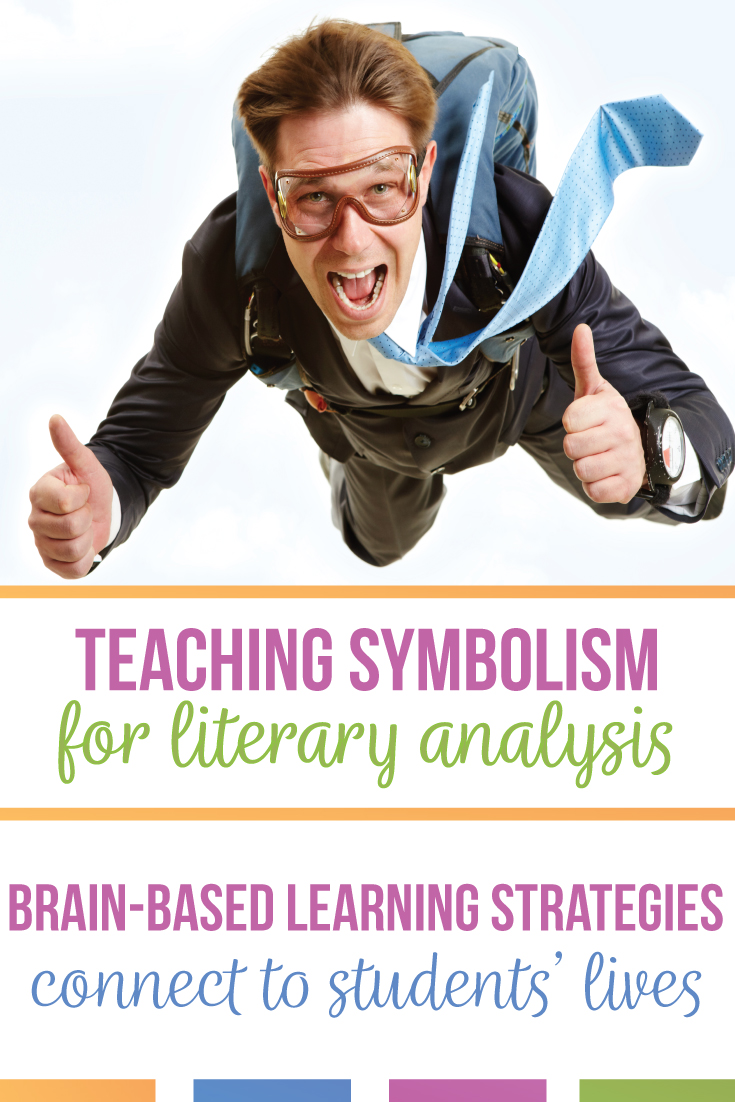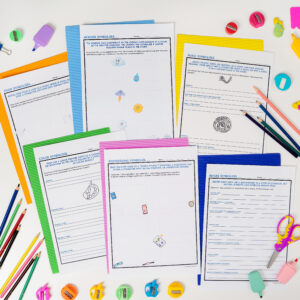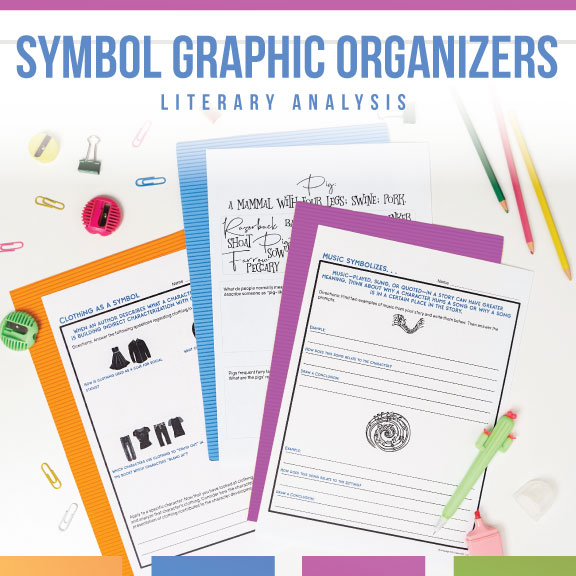Teaching symbolism for literary analysis… students may have difficulty understanding all of its implications. In this post, I’ve included ideas for how to teach symbolism.
A favorite literary term? Symbolism is a strong contender for me. When I teach The Great Gatsby, I must remind myself not to spend too much of a lesson mapping out characters and their colors. When I teach A Raisin in the Sun, I can’t (well, I probably COULD) spend a week discussing Mama’s plant. Not everyone is as excited as I am, and we must move to other ideas! One of the greatest parts of teaching symbolism is exploring the way it connects to other pieces of the story, and that is what our standards ask us to achieve.
Another great part of teaching symbolism discussion is the varying interpretations students have. Because symbolism is largely open to interpretation, it can be difficult to find agreement, especially with older students looking to quarrel for the sake of quarreling. The meaning of a symbol to my students teaches me about how they apply concepts from their lives to literature. Our symbolism class discussions are often some of our best discussions. Teaching symbolism in literature will be engaging!

How can teaching symbolism for literary analysis help students’ skills?
Teaching symbolism helps students analyze literature by teaching them to look for deeper meanings and connections. It allows them to understand the author’s intended messages and themes, enhancing their ability to critically analyze texts and develop more insightful interpretations of literary works.
Symbolism in literature refers to the use of objects, characters, or events to represent abstract ideas or concepts. It adds depth and layers of meaning to a literary work, allowing readers to engage with the text on a deeper level and explore themes and messages beyond the surface narrative.
Students can really get involved with symbolism, and that is wonderful. Once they grasp the concept, they enjoy reading more. An understanding of the literary term symbolism greatly improves students’ approaches to English class.
As I wrote this post, I realized that my methods for teaching symbolism in literature are rooted in brain-based learning. If you need ideas to start teaching symbolism, here are a few methods for teaching symbolism for literary analysis.
Explain colors.
Symbolism in literature is always present, especially concerning colors. A great first step with symbolism is to look for colors in literature—a deeper understanding of character or setting or for adding to figurative language. When students associate colors with another component, they have a better connection to their reading. Ask students to search for “color psychology wheel.” They will find lots of explanations of colors and hidden meanings. Using those color wheels can become a fun conversation when students disagree with explanations.
To prompt students to find these colors, show students how colors portray meaning. I use a car commercial: This Santa commercial for Mercedes-Benz caught my attention the other day. As Santa rolls out the cars, the road is labeled “nice” on one side, “naughty” on the other. Red cars are for naughty, white for nice, of course. White is pure and clean, while red is blood and dangerous. It’s a quick clip to introduce the literary term ‘symbolism’ or to emphasize colors and meaning in literature. The color red is a great conversation starter concerning symbolism.
I additionally review the setting of a story with colors. Students map out each setting and then review what each color is associated with a certain setting. Then, they can draw conclusions. What is the author illustrating by associating gray with a certain location? black? blue? If you teach the short story “The Scarlet Ibis,” you are probably familiar with teaching symbolism and setting.
Finally, another alternative to start a discussion about symbolism is by asking students where they have heard of colors with expressions. Brainstorm a list with them: feeling blue, green with envy, white as a ghost, feeling sunny. How do colors symbolize a message in expressions? Part of teaching symbolism is building on prior knowledge.
Explain everyday gestures.
Our gestures symbolize a message. Don’t let students use their middle fingers, but yes, that gesture symbolizes something. Examining everyday symbols makes the overview meaningful.
In our culture, we use the “ok” symbol, “thumbs up” symbol, and the “winding finger” for goofy or silly. Other cultures use different gestures. When politicians or diplomats travel, they are briefed about the culture’s expectations for gestures.
When students especially struggle with symbolism, this is the trick I use for connecting symbolism to prior knowledge. Students use symbolism in their lives. We just have to find it before teaching symbolism in literature.
Explain common symbols.
When I don’t introduce symbols with colors, I ask students to tell me what symbols are associated with common objects or ideas. I’m in America, so I often mention:
- Freedom (often, the American flag)
- Teachers (an apple)
- Peace (a dove or olive branch)
- Wisdom (owl)
And on! Building off students’ prior knowledge and proving to them that they do already understand (at least part of) symbols nicely begins discussions. Teaching symbolism in literature can be begin with basics and build. At the start of each school year, images float around the Internet and on advertising. What are they? Why symbols are associated with school?
Brainstorming a list of symbols connects language arts to learners’ lives and of course, you’ll soon be teaching symbolism for literary analysis.
Explain intangible symbols.
Sometimes, symbols are abstract with intangible symbols. The smell of pine, for example, often symbolizes winter or winter holidays. Bleach or chlorine symbolizes pool water and summer. Teaching symbolism involves talking about the abstract.
Love is often symbolized by intangible items: hearts, pulse, a complete circle.
Don’t start with teaching symbolism for literary analysis in mind. Instead, start with an abstract concept, ask questions, and move students toward analysis.
Explain weather.
The symbol of weather is often foreshadowing or highlighting emotions of characters or pieces of the plot. Teaching symbolism for literary analysis can start small.
To start this discussion, ask students what emotions an author conveys in literature. They might say:
- love
- hope
- sadness
- anger
- excitement
- foreboding
The list is not super important, but try to get several emotions for a nice discussion. Then ask students to identify which piece of weather makes sense with an emotion. Before long, students will be applying symbolism and reimagining ideas for their own writing.
Explain Shakespeare.
Shakespeare and symbolism might not be mentioned in every class, but if you see a struggle with symbolism, bringing in an excerpt might help.
Shakespeare is renowned for his masterful use of symbolism in literature. His works are filled with deep and intricate symbols that add layers of meaning to the text. For example, in Julius Caesar, the crown clearly represents power and fulfillment. Pull the section where Marc Antony offers Caesar the crown. Why would Caesar reject the crown? Why do appearances matter to him? Why does Caesar keep up appearances that he doesn’t need power? Carry over the ideas of the symbolism (of the crown) to character motivation, and you’re moving toward analysis.
Teaching symbolism for literary analysis might be a few step forwards, a few steps back. An excerpt, especially from renowned Shakespeare, will speak to your students.
For more ideas of how to teach symbolism and other literary concepts, download this activity set. It includes a PDF with these ideas in one spot. You can gain access by clicking on this image:
High school students might be familiar with story elements, even the use of symbolism. To advance critical thinking and move toward literary criticism, bring diverse perspectives concerning symbolism to students. Over the course of the text, model how to add annotations concerning symbolism.








